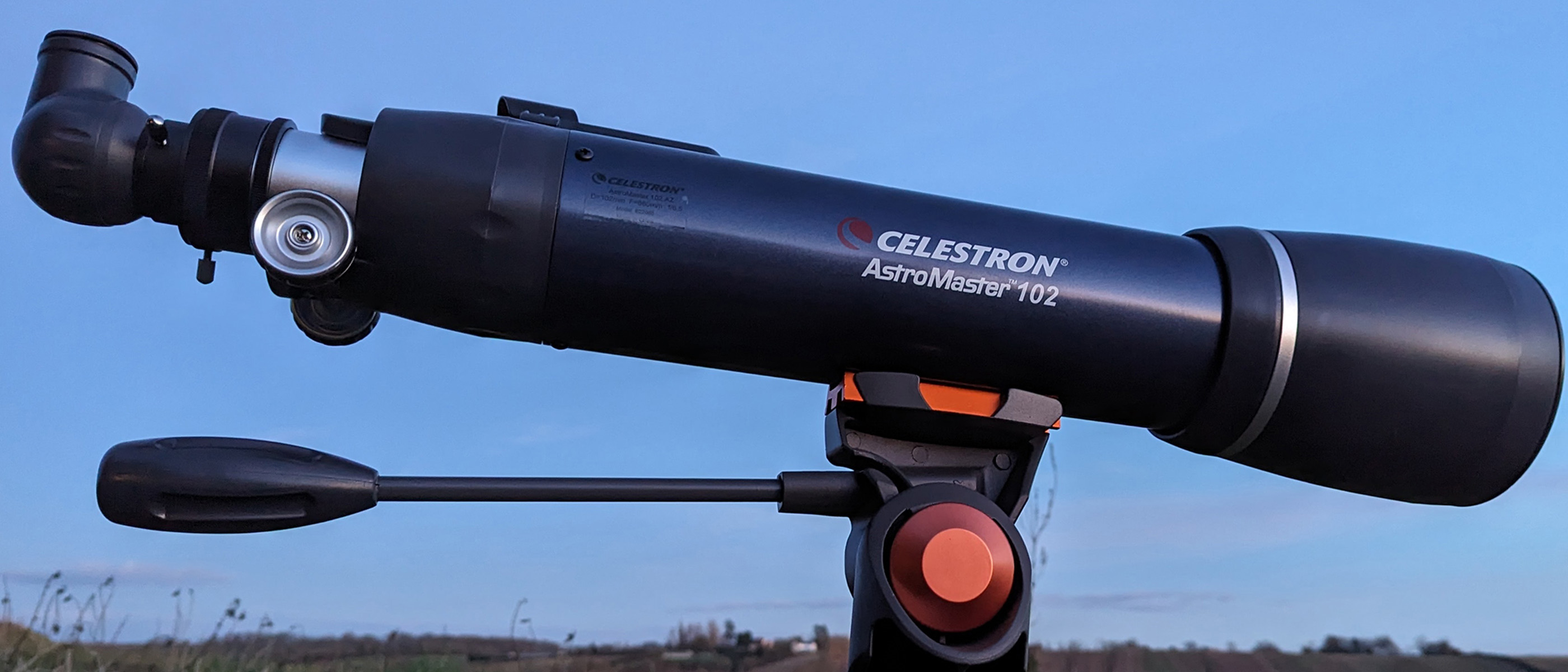Space Verdict
The Celestron Astromaster 102AZ might seem like the ideal compromise for a beginner's telescope, but being okay at everything means it doesn't really stand out for any particular subject.
Pros
- +
Great quality optics
- +
Dual purpose for astronomy and wildlife viewing
- +
Easy to set up
Cons
- -
Short tripod
- -
Clumsy mount
- -
Not the best value
Why you can trust Space.com
The Celestron Astromaster 102AZ promises to be the all-purpose beginner's telescope for everyone, with optics and mount suitable for both astronomy and terrestrial viewing.
Up front is a four-inch (102mm) diameter objective lens, which is unusually large for a refractor telescope. Most telescopes of this size and above are reflectors, using mirrors rather than lenses. At the other end, a 90-degree star diagonal makes viewing slightly easier by presenting the eyepiece to the user in a more comfortable position. This has a standard 1.25-inch fitting, enabling a vast choice of accessory lenses. The standard kit includes good-quality Celestron 10mm and 20mm eyepieces.
The scope is attached to the tripod by a simple altitude-azimuth (alt/az) mount, with the vertical altitude adjustment via a long pan handle control and a thumb lever horizontal azimuth lock. A red dot finder helps the user point the telescope towards the target, whether on the ground or in the heavens.
The Astromaster 102AZ is pitched towards the premium end of the beginner's telescope market, presumably because this single instrument can perform as both terrestrial and astronomical telescopes.
We've named it the best 'grab and go' telescope in our best telescopes for beginners guide. It's relatively lightweight for a refractor and its quick and easy setup makes it ideal as a portable telescope for stargazing excursions.
Celestron Astromaster 102AZ telescope review
Celestron Astromaster 102AZ telescope: Design
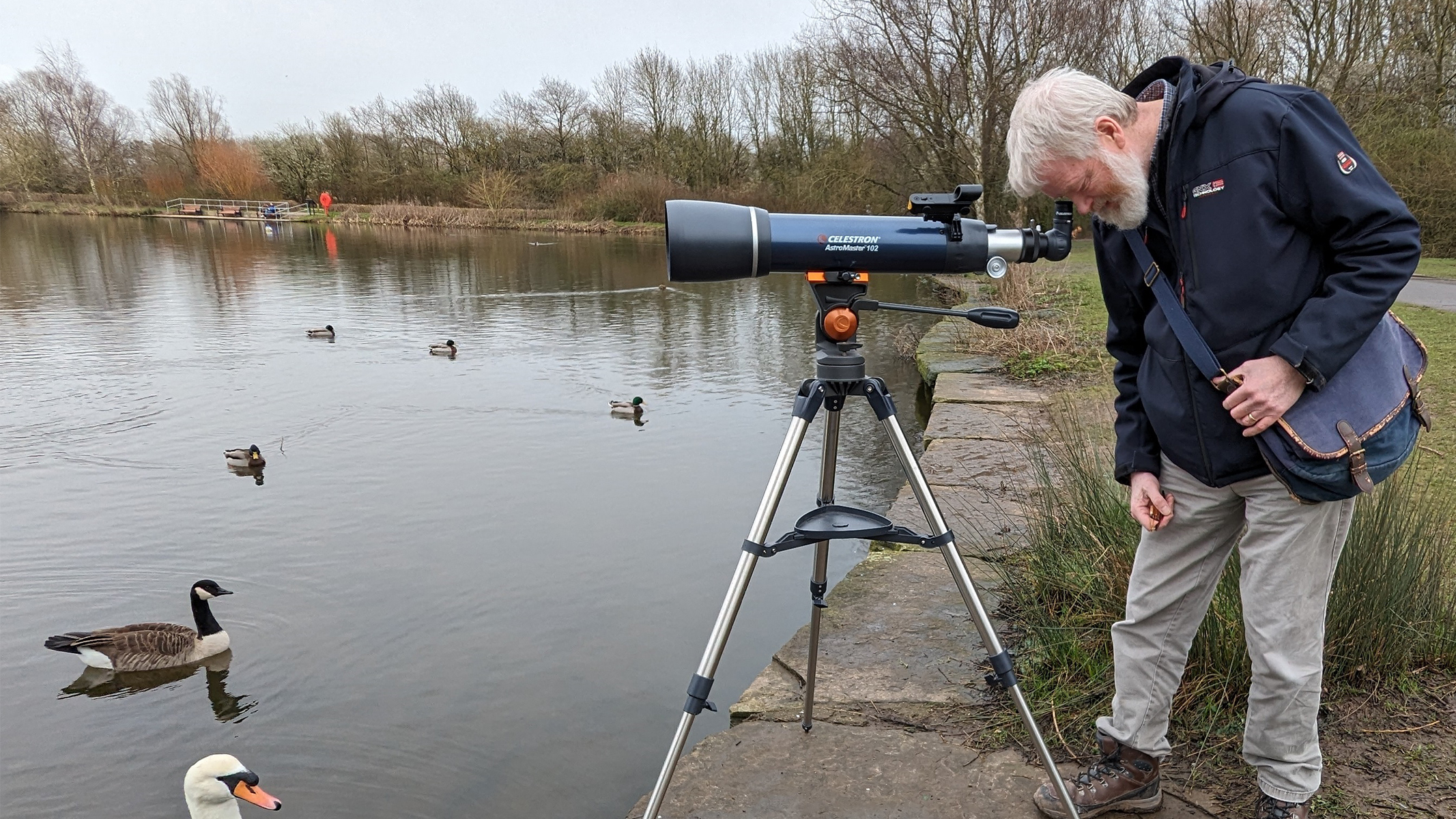
- Impressive primary lens
- Simple Alt/Az mount
- Stylish design
Optical design: Refractor
Optics: fully coated
Aperture: 4 inch (102mm)
Focal length: 26 inches / 660mm
Focal ratio: f/6.5
Eyepiece focal length: 10mm / 20mm
Magnification: 33x / 66x
Prism type: Erect image 90 deg
Total kit weight: 12.9 lb inc tripod and mount, 5 lb telescope
Mount type: Alt/azimuth, manual
Apparent field of view: 1.5 deg / 0.6 deg
There's something about a traditional refractor telescope with a big lens up front that catches the imagination, and the Celestron Astromaster 102AZ does not disappoint. The objective lens is an impressive piece of fully-coated glass that does a great job of collecting light, whether from distant objects in the universe or wildlife a hundred yards away on a pond.
This dual functionality is a key aspect of the design. The telescope is intended to be equally useful for astronomy and naturalism, potentially saving the buyer money.
Breaking space news, the latest updates on rocket launches, skywatching events and more!
A conventional refractor design such as this has the benefit for the new or inexperienced user of delivering an erect image, where objects appear the right way up. This makes it easier to center the instrument because you simply ease the telescope to the right to see an object on the right of the view, and vice versa.
A helpful feature missing from the Astromaster 102AZ is a slow motion control, which allows the user to track objects more easily as they move across the sky and fine-tune targeting to put the subject in the center of the field of view.
The telescope comes with a 90-degree diagonal onto which a variety of eyepieces can be fitted. The two supplied eyepieces, 10mm and 20mm focal lengths provide magnifications of 66x and 33x, respectively, so the user has wide-field and close-up viewing options straight out of the box.
The mount looks quite stylish in black and gray with orange details, sitting atop the chrome steel tripod. However, the two hand controls are rather clumsily located, with the horizontal azimuth lock being a gray thumb lever on the top plate. The altitude lock is via an extended pan handle which twists to lock or unlock. In practice, we found it is easier to leave azimuth unlocked and control steering entirely with the panning handle — although this brings its own disadvantages (see below).
The whole rig rests on a polished tubular steel tripod. The tripod legs have only one extending section, which limits the maximum height that the telescope can be mounted to (51 inches, 130cm, at the center). This is barely high enough for an adult to peer into when the tube is horizontal while looking at terrestrial targets. When tilted skywards for astronomy, a seat is necessary. But we imagine this would be of benefit for younger stargazers.
Celestron Astromaster 102AZ telescope: Functionality
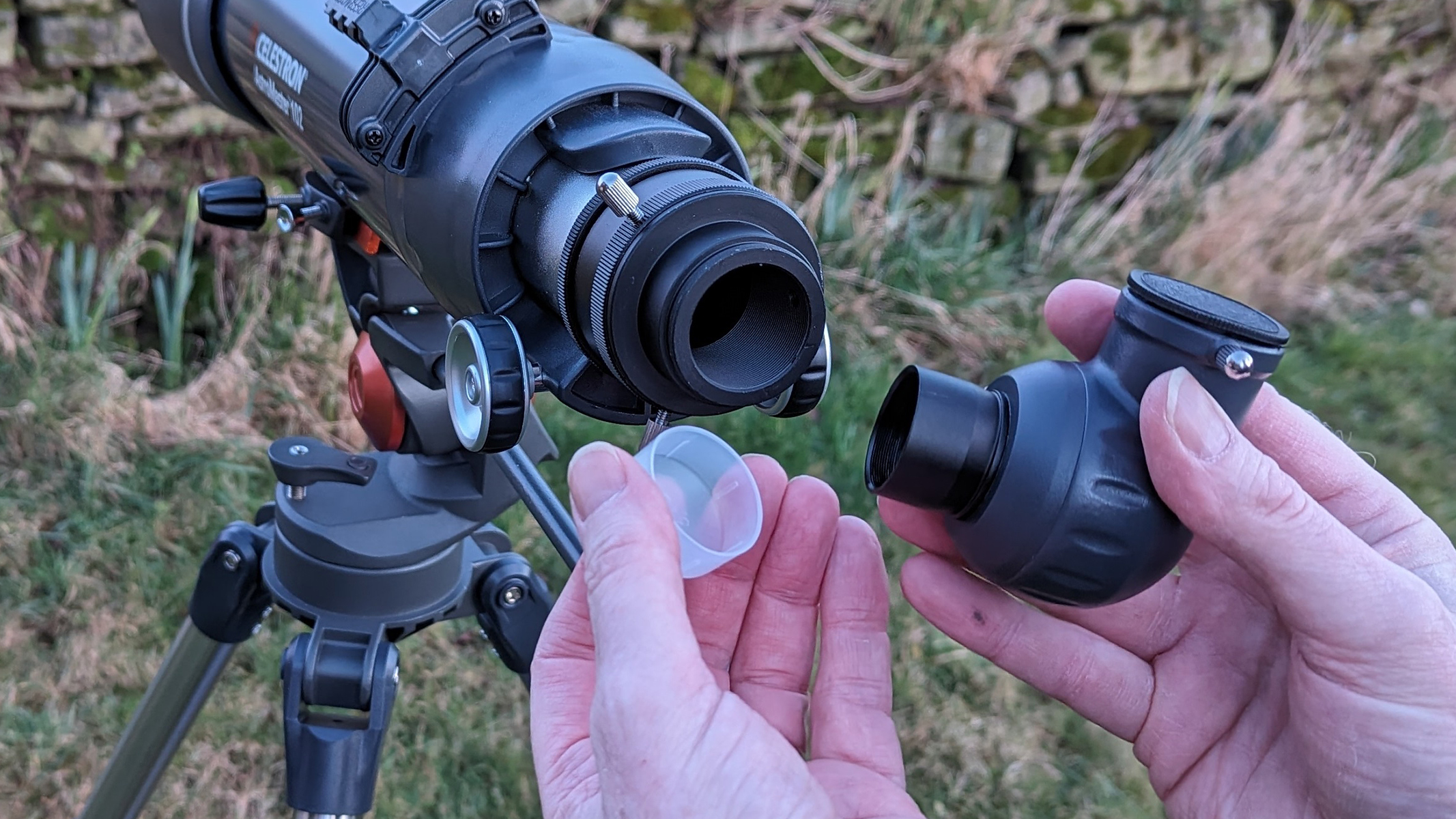
- Includes red dot finder
- Awkward controls
- The tripod should be taller
Setting up the Celestron Astromaster 102AZ is straightforward. The telescope tube and the tripod are both fully assembled and simply require mating together by sliding the tube mount into the dovetail mounting bracket and tightening the mounting knob and additional safety screw by hand. The accessory tray should be fitted to the tripod first, for additional stability. Note that the instructions confusingly say to rotate the tray clockwise but the illustration shows counterclockwise (clockwise is correct).
First impressions are that the telescope looks pretty sweet but in reality it is too low to the ground for an adult. It feels as if there should be a second extension on the tripod.
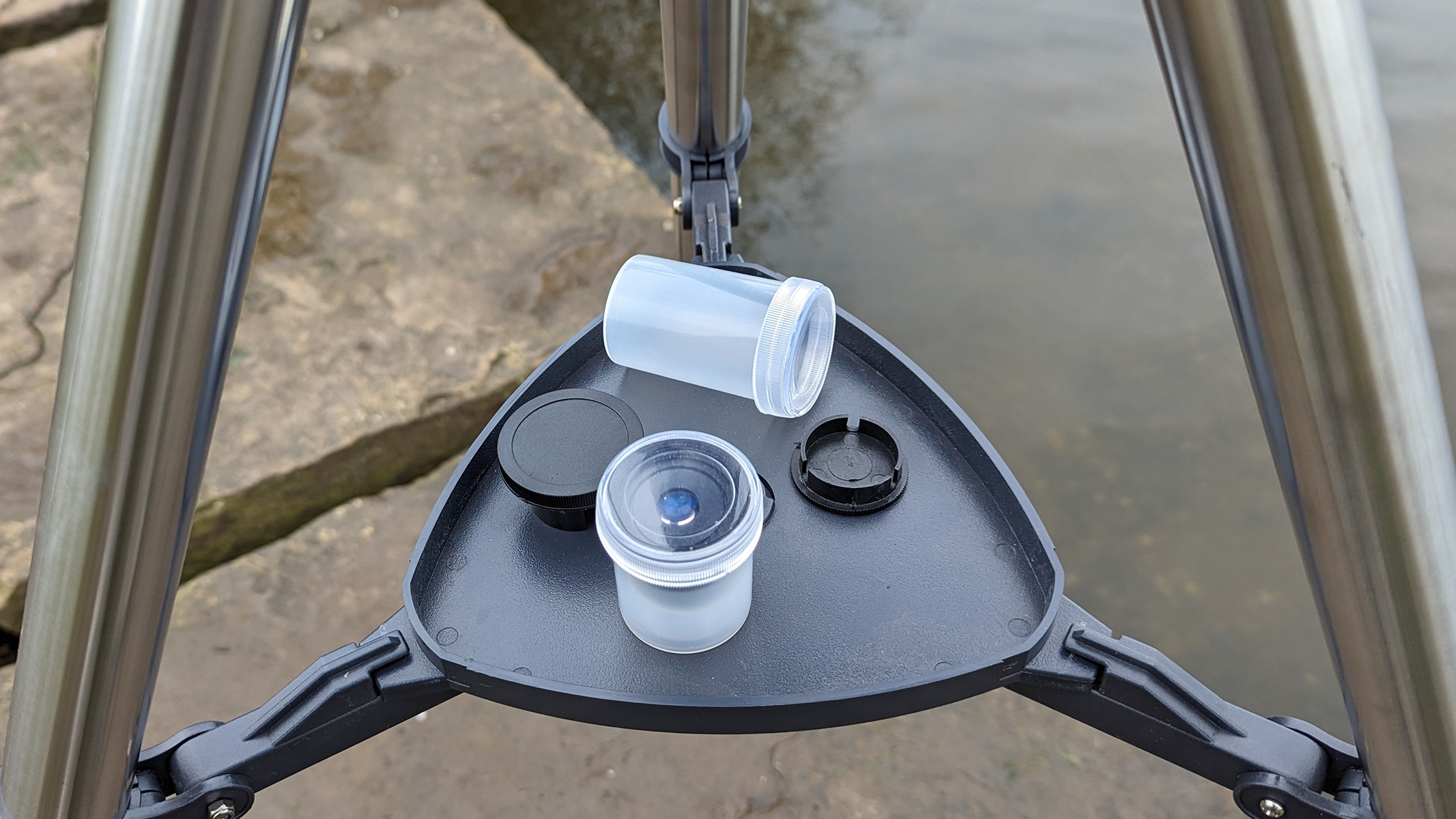
Instead of a conventional finderscope, Celestron packages a red dot finder with the Astromaster 102AZ. Not all astronomers are enthusiastic about this device but it works perfectly well once it is aligned and used properly.
We have found the secret is to keep both eyes open. Two small black screws fix the red dot finder to the tube, requiring a small Phillips screwdriver (not included) — the only tool needed for assembly. This should be done in daylight and indoors to avoid the danger of losing these screws.

When it was all set up and ready for observations, the awkwardness of the controls became apparent. The primary steering is done via the long panhandle, which twists left to unlock and right (clockwise) to lock. Beware of reaching under the tube rather than using the handle, as you will find the focus mechanism instead and your hand will pick up grease.
Celestron Astromaster 102AZ telescope: Performance
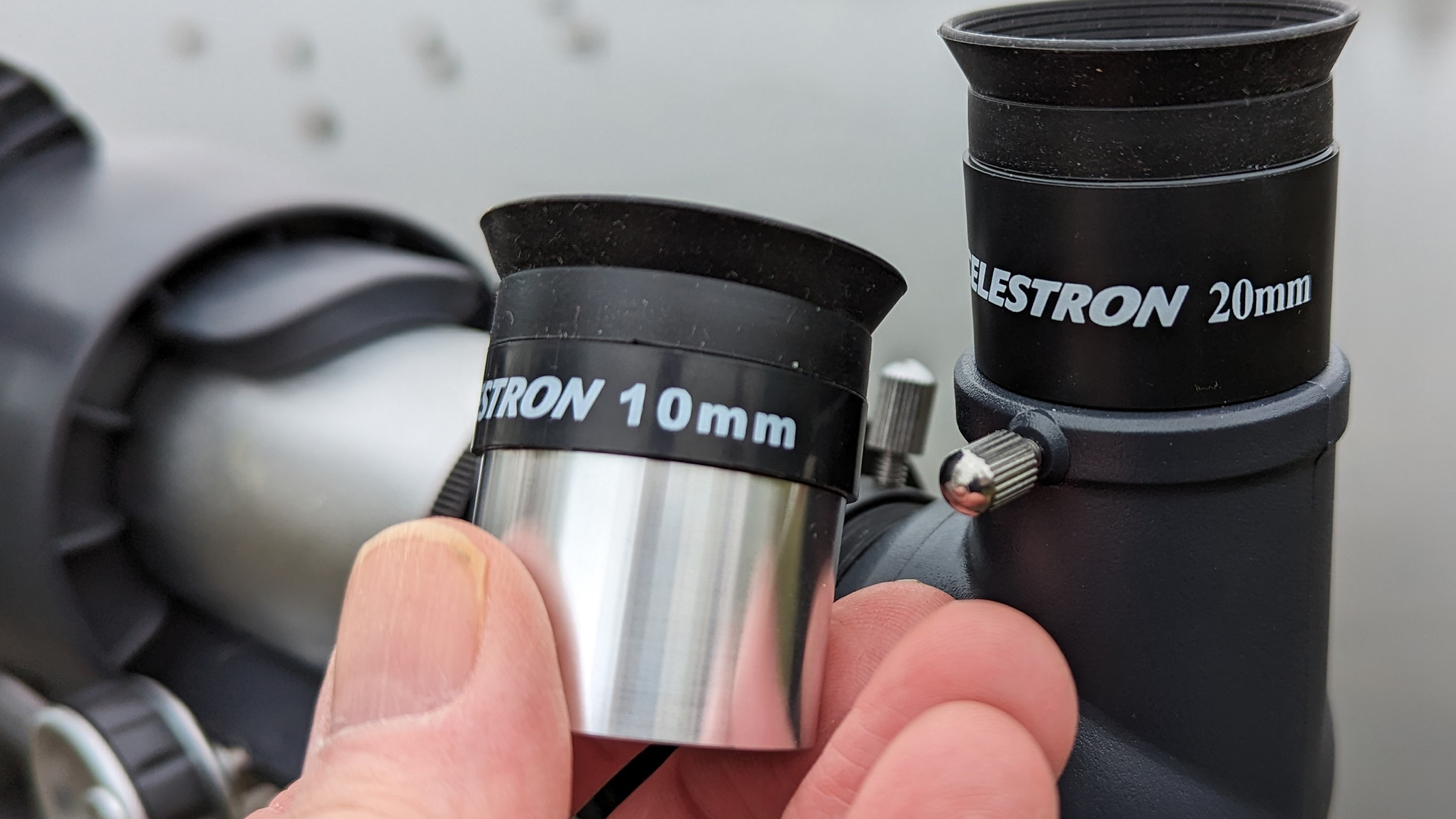
- Lack of slow-motion control
- Adequate color rendition
- Short tripod
The first light on our trial came from the king of the solar system, Jupiter, and the view did not disappoint. The gas giant was easily found and displayed clear weather bands with both the 20mm and 10mm eyepieces, its four large Galilean moons strung around it like diamonds. It's always a majestic scene and gives a good impression of the optical quality of this instrument.
The 10mm eyepiece provides a closer look, of course, and in our tests also delivered slightly less contrast than the lower-power 20mm. This is quite normal and to be expected.
Turning to the full moon, both eyepieces showed sharp detail on the lunar surface and a decent contrast between the bright highlands and dark mare. A lunar filter would help here, as would a partial moon phase when shadows highlight the satellite's surface texture.
Color rendition proved only adequate in our tests, with the red supergiant Betelgeuse and the blue giant Bellatrix, conveniently near to each other in the constellation Orion, providing good targets.
Gaseous and diffuse objects such as galaxies and nebulas are challenging targets for beginner's instruments. The Celestron Astromaster 102AZ revealed the M42-M43 Orion nebula pretty well. Using averted vision, the nebula was clearly visible, looking much like a faint gray cloud.
Within the nebula is an excellent target to show the resolution of a small telescope — this is the Trapezium, a cluster of four stars with magnitudes between 5.1 and 8.0. The 20mm low-power eyepiece revealed three of these, while the high-power 10mm clearly showed all four, with a distinct separation between them – decent performance for a telescope in this market segment.
The quality of the optics is severely let down by the tripod and telescope mount. The tripod is so short that a seat or chair is necessary, which makes finding targets a bit clumsy. It is also less stable than an astronomy tripod should be.
While the mount holds the telescope to the tripod well enough, the main pan handle control requires a couple of turns to loosen fully and another couple to tighten, meaning that the target is lost more often than not. There is a bit of sag when tightening, so it must be pointed slightly above the target, and any adjustment to either direction or focus makes the whole assembly wobble for a couple of seconds.
The biggest problem is the lack of slow-motion control, so any repositioning of the scope to account for the rotation of the earth can only be done via the wobble-inducing panhandle. At high power, an object will transit the field of view in a couple of minutes, and a fair chunk of that can be lost on positioning and focusing. With more time lost to the wobble, there is less time to do astronomy.
Should I buy the Celestron Astromaster 102AZ telescope?
This telescope is a bit of a conundrum. It is appealing to users who may want to do both astronomy and wildlife spotting, as it should allow them to buy one instrument instead of two.
The optics are good for both purposes, giving sharp bright images both of the night sky and terrestrial subjects. But it has two main drawbacks. The tripod and mount are essentially inadequate for either purpose. It is also quite an expensive instrument for what it is.
The same money could be spent on two dedicated telescopes, one for sky watching and one for nature, or perhaps on a decent astronomical telescope and a pair of binoculars.
If you decide the Celestron Astromaster 102AZ is the right telescope for you, you might consider the Astromaster Accessory Kit to enhance the instrument. This consists of a 15mm Kellner eyepiece, a high-power 6mm Plossl eyepiece, and a 2X Barlow lens which doubles the magnification of any eyepiece. Also in the kit are a couple of filters to improve views of the moon and planets.
If the Celestron Astromaster 102AZ telescope isn't for you
We liked the Celestron Astromaster 102AZ telescope for its optical quality, but the short tripod and clunky mount combined with a slightly ambitious price means that there are plenty of attractive alternatives available.
The Orion Observer 90mm Equatorial refractor has a longer focal length, meaning it will provide higher magnification with the same eyepiece but a slightly smaller aperture. It comes with an equatorial mount and tripod and is good value for money.
The Sky-Watcher Evostar-90 (EQ2) has specifications quite similar to those of the Orion. It offers more magnification but less light-gathering power than the Celestron and also has a proper tripod and equatorial mount.
The Celestron AstroMaster 114EQ uses a main mirror rather than glass lenses, making it shorter and lighter than the Astromaster 102AZ. Its larger diameter gathers more light, and it also has an equatorial mount.

Russ Swan is a UK-based freelance science writer and author with a love of all things related to space and aviation. He built his own 100mm refractor telescope from some bits found in a military surplus store, and once had lunch with Neil Armstrong. His popular science book The Physics Behind… explains not just how the universe works, but why. He tweets (occasionally)!
